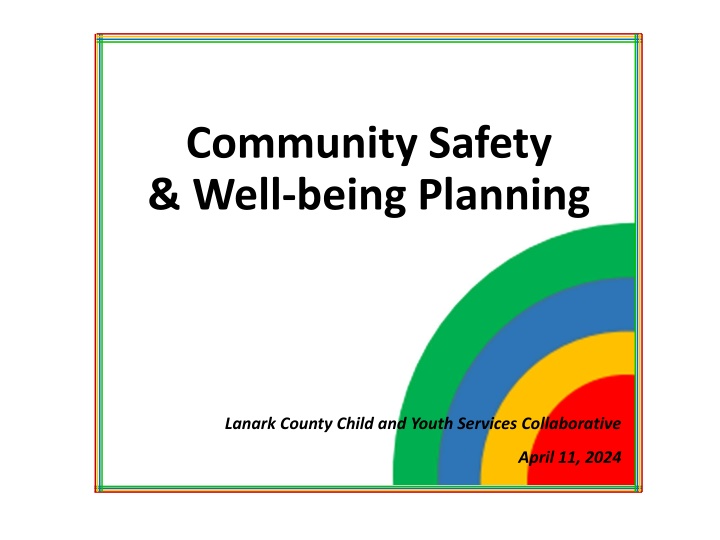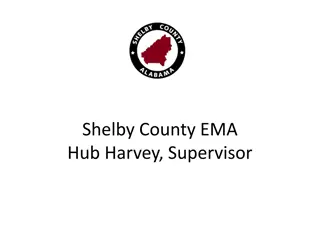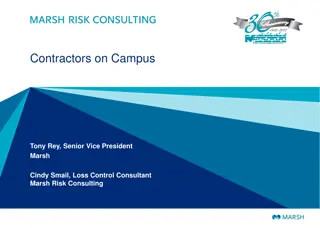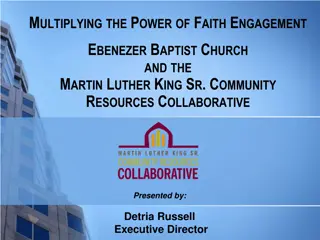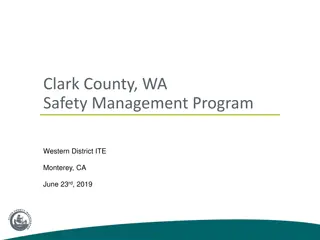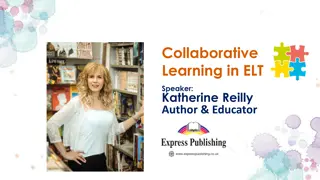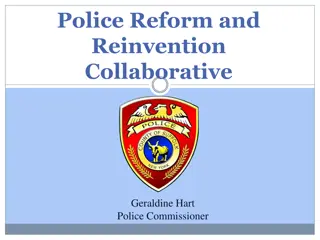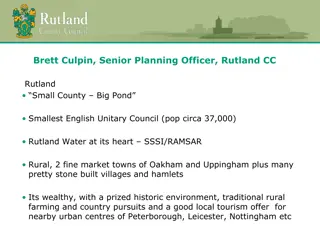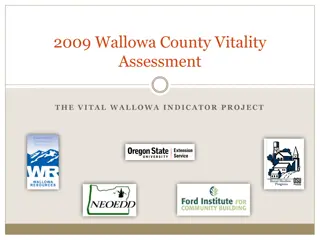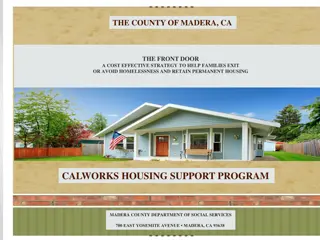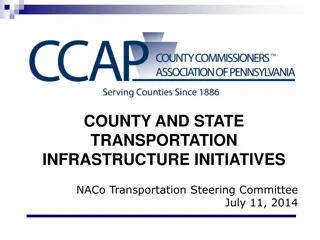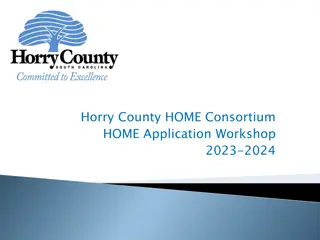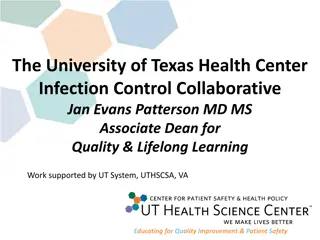Collaborative Community Safety and Well-being Planning in Lanark County
The Community Safety & Well-being Planning in Lanark County aims to prevent crisis situations by bringing together human-service sectors through a collaborative approach. Key components include a Situation Table for intervention in high-risk situations and the development of a community plan to address local risks. The initiative is based on a strength-based model, emphasizing asset identification and support network establishment. The plan involves a multi-sectoral advisory committee and consultations with various stakeholders, including youth and marginalized communities. Legislative requirements mandate regular reviews and revisions of the safety plan. Ongoing funding supports the implementation of strategies to enhance community safety and well-being.
Download Presentation

Please find below an Image/Link to download the presentation.
The content on the website is provided AS IS for your information and personal use only. It may not be sold, licensed, or shared on other websites without obtaining consent from the author.If you encounter any issues during the download, it is possible that the publisher has removed the file from their server.
You are allowed to download the files provided on this website for personal or commercial use, subject to the condition that they are used lawfully. All files are the property of their respective owners.
The content on the website is provided AS IS for your information and personal use only. It may not be sold, licensed, or shared on other websites without obtaining consent from the author.
E N D
Presentation Transcript
Community Safety & Well-being Planning Lanark County Child and Youth Services Collaborative April 11, 2024
Background A Community Safety Model In 2015 Pilot project brought multiple human- service sectors together to collectively identify systemic issues and risk factors prevalent locally and provide a network of support in order to prevent crisis situations. Two main components: 1. Situation Table with agencies collaborating to identify and intervene in situations of acutely elevated risk 2. Development of a community plan for safety and well-being that identifies local prevalent risks and strategies to mitigate them
Collaborating Ahead of the Curve Community-driven, regional plan undertaken prior to legislation OWG framework/outline Advisory Committee established with charter and terms of reference (late 2016) Plan outline and consultations (2016/17) Strength-based: Identifies and builds on assets Approvals: Advisory Committee July 4, 2018, Lanark County Council approved in principle Aug. 29, 2018; local municipalities into Winter 2019 Advisory Committee and Working Groups advancing strategies Progress Update released July 2022 Ongoing grant funding through Perth PSB
Community Safety and Policing Act & O. Reg 414/23 Publication and Review CSWB section similar to PSA, with some additional specifics around Advisory Committee membership and submission of the plan to the Minister. Plans prepared under PSA are deemed to have been prepared and adopted under CSPA. Regulation: Municipalities are required to publish completed plan on Internet within 30 days of adoption and can publish it in any other form desired. NEW in Regulation: Municipality must review and, if appropriate, revise plan within four years after day of adoption and every four years thereafter. (If adopted before 2021, review and revise by July 1, 2025)
Community Plan for Safety and Well-being: Additional Legislative Requirements Establish a multi-sectoral advisory committee including representatives from, but not limited to: Health/mental health services Educational services Community/social services Community & custodial services to children or youth Municipal council member or municipal employee Rep. of PSB or detachment commander/delegate Conduct consultations with advisory committee, members of public (incl. youth; members of racialized groups; First Nations, M tis, Inuit communities; community organizations that represent these groups.)
Advisory Committee SECTOR Justice ORGANIZATION Lanark County OPP, Smiths Falls Police Service Community Organizations & Youth United Way, Perth & District Community Foundation, RNJ Youth Services, Family & Children s Services, Open Doors/Planet Youth Health Care Health Unit, Lanark County Mental Health, Rideau Community Health Services, Lanark County Paramedic Service Social Services (& Housing) Lanark County Social Services Victim Services Lanark County Victim Services, Lanark County Interval House Education Upper Canada District School Board, Catholic District School Board of Eastern Ontario Indigenous Plenty Canada Local Government Lanark County Council, Town of Smiths Falls
Community Plan for Safety and Well-being: Additional Legislative Requirements Contents of the plan: Identifying priority risks (e.g. systemic discrimination and other social factors that contribute to crime, victimization, addiction, drug overdose and suicide) Identifying strategies to reduce the prioritized risk factors (e.g. new services, changing/ coordinating existing services) Setting measurable outcomes
Discussion: Preliminary Themes & Risk Areas Health: physical health (including access to care primary, long-term care, end- of-life care) mental health (children and adults) substance use (including harm reduction) Affordability and Quality of Life: income (wealth and income gaps) employment housing and homelessness transportation (including active and shared transportation) food security climate change and environment belonging and civic engagement Violence Against Persons: SADV/IPV/gender-based (including gender diversity) (and restorative options) hate-motivated crime child abuse elder abuse justice system changes (if not otherwise noted in other risk areas) Priority Populations and Diversity: children and youth seniors and elderly Indigenous LGBTQS+ New Canadians and immigrants Disabilities/Accessibility
Consultations to Date Partner Day 23 participants (assets, gaps, evaluation and strategies) Community Survey 393 responses Agency Survey 37 responses Council/PSB/CPAC Focus Session 9 participants (pressures/gaps/issues, strategies, municipal involvement) Focus groups in risk areas (LCCYSC, SAAC, SADV/Forums) more to come Advisory Committee Members
LCCYSC Focus Group Pressures body image, social media, money, poverty, developmental gaps, barriers for marginalized groups and immigrants, educational challenges, discrimination and social exclusion, bullying, SA and GBV, social difficulties, healthy relationships, wait times for services, risk of child exploitation, vaping/peer pressure, gender diversity/expression, overscheduling, minimal supports at school, family conflict What factors are most influencing children s mental health difficulties social media, poverty, family violence, global issues, lack of connection to culture, peers, parents, teachers, barriers/issues faced by immigrant children, accessing supports for long enough, having physician to review medications, long wait lists, poverty, familial stress, violence, shame and stigma related to speaking up.
LCCYSC Focus Group How can we best support parents Parents need to support each other, poverty reduction, mental health support for families, immediate responses when struggling, healthy family events and activities, parent support meetings and workshops, offer resources What key gaps in services for kids/families have you found parents aren t sure where to get help, long wait lists, expensive alternatives, in-school supports, 2SLGBTQIA+ specific expertise, education about hate speech and violence and actions, education around being a welcoming and safe community on several levels (immigrant families, single- parent households), violence survivors)
Assets and Gaps Priority Population Assets (not a comprehensive list!) School programs and creating safer spaces Healthy Babies Healthy Children FCS working to address over-representation of Indigenous population in care FCS data collection Ready Set Go (FCS) Youth centres Triple P Parenting program Inclusive Voices Good collaboration and problem solving Restorative justice
Priority Population Gaps (not a comprehensive list!) System navigation for newcomers Racism, bullying and discrimination and ways to address it Indigenous population supports Limited FASD practitioners in region Identifying students and families in need; resistance to/awareness of supports; effects of family poverty Parents knowing how to make referrals Sustainable funding for youth supports More resources for young families Wait lists Risk of child exploitation; healthy connections/relationships understanding Other identified pressures
Key Takeaways So Far Address basic needs housing, food, income and other risks will be mitigated. (This will look different for different populations lived experience) Protect and build upon the assets we have. We collaborate well and need to continue to do so upstream. (Find root causes for the risks.) Increase awareness of what is available and share amongst professionals and public. Continue to learn and train and educate.
Lenses Social determinants of health Upstream prevention (root causes) Climate Indigenous/TRC EDI Anti-violence (Inquest recommendations, etc.)
Next Steps Additional consultations, data collection/analysis Update and share assets and gaps document with advisory committee Develop goals and outcomes with measurables Begin draft - report back to Advisory Committee Revisions based on feedback from advisory committee Presentations to Councils Adoption of report Implementation document with strategies as part of process
Questions? Stephanie Gray Coordinator Lanark County Situation Table Community Safety and Well-being Plan LanarkCST@gmail.com 613-812-3778
